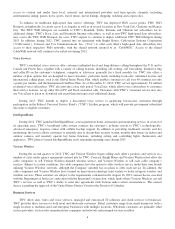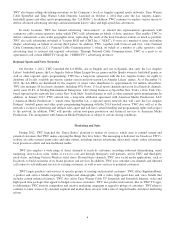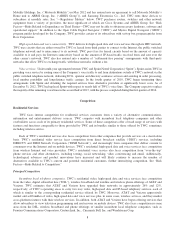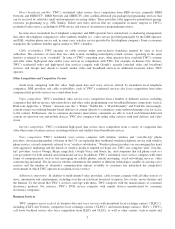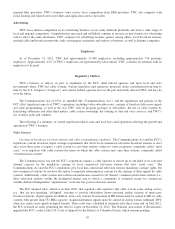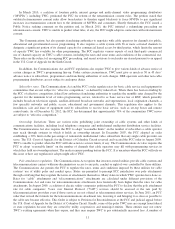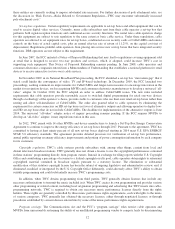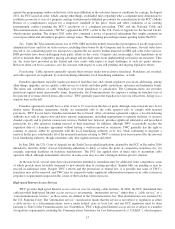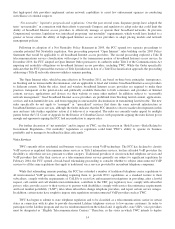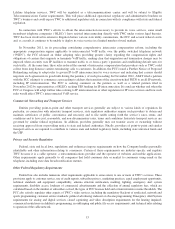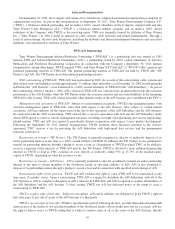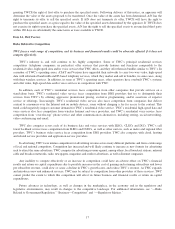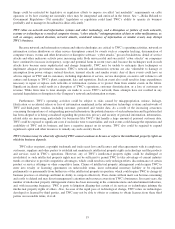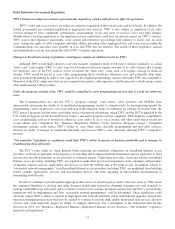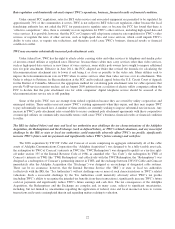Time Warner Cable 2012 Annual Report Download - page 22
Download and view the complete annual report
Please find page 22 of the 2012 Time Warner Cable annual report below. You can navigate through the pages in the report by either clicking on the pages listed below, or by using the keyword search tool below to find specific information within the annual report.these entities are currently seeking to impose substantial rate increases. For further discussion of pole attachment rates, see
the discussion in “Risk Factors—Risks Related to Government Regulation—TWC may encounter substantially increased
pole attachment costs.”
Set-top box regulation. Certain regulatory requirements are applicable to set-top boxes and other equipment that can be
used to receive digital video services. Currently, many cable subscribers rent from their cable operator a set-top box that
performs both signal-reception functions and conditional-access security functions. The rental rates cable operators charge
for this equipment are subject to rate regulation to the same extent as basic cable service. Under these regulations, cable
operators are allowed to set equipment rates for set-top boxes, conditional-access security cards or CableCARDs and remote
controls on the basis of actual capital costs, plus an annual after-tax rate of return of 11.25%, on the capital cost (net of
depreciation). Regulations prohibit cable operators from placing into service new set-top boxes that have integrated security
functions. DBS operators are not subject to this requirement.
In June 2007, the FCC initiated a Notice of Proposed Rulemaking that may lead to regulations covering equipment sold
at retail that is designed to receive two-way products and services, which, if adopted, could increase TWC’s cost in
supporting such equipment. This Notice of Proposed Rulemaking remains pending. In June 2008, cable operators and
consumer-electronics companies entered into a Memorandum of Understanding that establishes a national platform for retail
devices to receive interactive (or two-way) cable services.
In November 2009, in its National Broadband Plan proceeding, the FCC identified a set-top box “innovation gap” that it
stated could hinder the convergence of video, TV and IP-based technology. In December 2009, the FCC launched two
proceedings, seeking comment on improvements for CableCARDs and longer-term measures to encourage innovation in the
market for navigation devices, such as requiring MVPDs and consumer electronics manufacturers to develop a universal “all-
video” adapter. In October 2010, the FCC adopted an order to address CableCARD issues. The new rules included
requirements that cable operators provide reasonable access to switched digital programming for retail one-way devices
through a technology of the operator’s choice, provide credits to customers who use their own retail set-top boxes rather than
renting and allow self-installation of CableCARDs. The order also granted relief to cable operators by eliminating the
requirement for certain connectors on HD set-top boxes in favor of alternative outputs and allowing operators to deploy low-
end HD set-top boxes that do not include CableCARDs. The deadline for implementation of the alternative outputs is June
2014. The universal “all-video” adapter notice of inquiry proceeding remains pending. If the FCC requires MVPDs to
develop an “all-video” adapter, it may impede innovation in this area.
In 2012, TWC joined with 14 other MVPDs and device manufactures to launch a Set-Top Box Energy Conservation
Agreement to continue to improve the energy efficiency of set-top boxes through 2017. Pursuant to the agreement, TWC has
committed to having at least ninety percent of all new set-top boxes deployed starting in 2014 meet U.S. EPA ENERGY
STAR 3.0 efficiency standards. The agreement provides detailed processes for verification of set-top box performance,
annual public reporting on energy efficiency improvements and posting of power consumption information by each company
for its customers.
Copyright regulation. TWC’s cable systems provide subscribers with, among other things, content from local and
distant television broadcast stations. TWC generally does not obtain a license to use the copyrighted performances contained
in these stations’ programming directly from program owners. Instead, in exchange for filing reports with the U.S. Copyright
Office and contributing a percentage of revenue to a federal copyright royalty pool, cable operators obtain rights to retransmit
copyrighted material contained in broadcast signals pursuant to a statutory license. The elimination or substantial
modification of this statutory copyright license has been the subject of ongoing legislative and administrative review, and, if
eliminated, modified or interpreted by the U.S. Copyright Office differently, could adversely affect TWC’s ability to obtain
suitable programming and could substantially increase TWC’s programming costs.
In addition, when TWC obtains programming from third parties, TWC generally obtains licenses that include any
necessary authorizations to transmit the music included in it. When TWC creates its own programming and provides various
other programming or related content, including local origination programming and advertising that TWC inserts into cable-
programming networks, TWC is required to obtain any necessary music performance licenses directly from the rights
holders. These rights are generally controlled by three music performance rights organizations, each with rights to the music
of various composers. TWC generally has obtained the necessary licenses, either through negotiated licenses or through
procedures established by consent decrees entered into by some of the music performance rights organizations.
Program carriage. The Communications Act and the FCC’s “program carriage” rules restrict cable operators and
MVPDs from unreasonably restraining the ability of an unaffiliated programming vendor to compete fairly by discriminating
12




